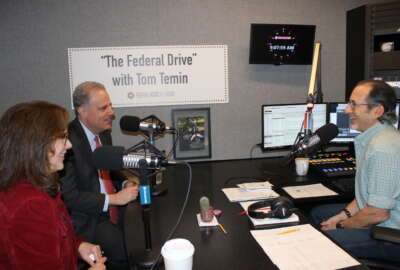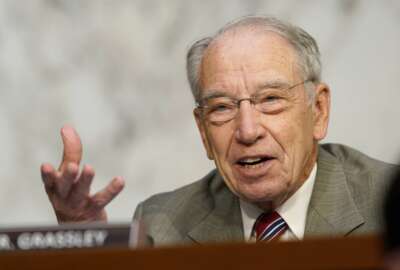Hubbard Radio Washington DC, LLC. All rights reserved. This website is not intended for users located within the European Economic Area.
On Air: Federal News Network
Trending:
When the going gets tough, good leaders lead
Times of tight budgets, impending sequestration and a possible government shutdown require good leaders who can make tough decisions. But who are those leaders?...
wfedstaff | April 17, 2015 4:43 pm
From sequestration to furloughs, the federal pay freeze and the continuing resolution, the federal workforce is facing a challenging road ahead.
These difficult times call for tough choices and the leaders who can make them.
“Without question, the choices that are made are going to be tough ones,” said John Baldoni, who writes and speaks about leadership. “This management conundrum, doing more with less, that’s a good thing, but after a while, less does not equal more. There’s a reason those two terms are defined differently. So, how do you make the best choices? … People can put up with an environment for a while, but it’s up to the leaders to find ways to energize the organization.” 
“Great leaders have the ability to unite the hearts and grow the skills and vision of their team members, passionately working together to make life better for the people they serve,” wrote Nancy Tyler, public service and citizen outreach manager at the Federal Citizen Information Center at the General Services Administration, in her nomination of FCIC Director Beverly Godwin.
“When I think about what makes someone a great leader, I think about someone who is very knowledgeable in a certain area, someone who has a genuine interest in leading results-driven change, someone who inspires, listens attentively, asks tough thought-provoking questions, someone who is interested in the well-being of others, someone who believes in and is committed to successful mission- achievement, and someone who possesses the basic principles of leadership — trust and communication,” wrote an employee at the Energy Department’s Energy Information Administration, who nominated Thomas D. Williams, EIA’s assistant administrator for resource and technology management.
A panel of judges made up of leadership experts, federal managers and Federal News Radio staff members reviewed the 62 nominations received, and chose five finalists to be recognized as “Top Leaders in Federal Service.”
The finalists are:
- Bev Godwin, director, Federal Citizen Information Center, General Services Administration
- Michael Parker, director, Legal Processing Division, Chief Counsel, Internal Revenue Service
- Marcia Pelberg, director, Leadership & Cross-Functional Programs, Internal Revenue Service
- Charles Rothwell, director, Division of Vital Statistics, CDC/National Center for Health Statistics
- Thomas Williams, assistant administrator, Resource and Technology Management, Energy Information Administration, Department of Energy
(Click on the finalists’ names above to view exclusive profiles, videos and Q&As with each of them.)
What makes a good leader?
Federal News Radio also asked our judges to share the criteria they used to pick the five finalists.
“Good leadership understands that teamwork, excellence and value are what make the leader, staff and organization excel,” wrote Angela Bailey, chief human capital officer at the Office of Personnel Management.

“As a Warren Bennis fan, I agree when he says, ‘Leadership is the capacity to translate vision into reality,'” wrote Gail Lovelace, former chief people officer and director of presidential transition at GSA. “Leaders must visibly care about the people and the mission. They must have the highest level of integrity. They must have a vision and be inspirational. They must believe in their people and treat them with respect and trust. They have a unique ability to bring out the best in others.”
“Leadership comes down to you doing what the organization needs you to do,” said Baldoni, who served on the panel of judges that picked the Top Leaders. “This is very easy to do when things are good, because it means growing the enterprise, hiring people. But, it’s challenging when you are faced with hard choices, often between two rights. In other words — two options, what do you choose? Sometimes it’s which of two good people do you promote or, in a more challenging situation, which of two good people do you have to let go due to budget requirements.”
Top Leaders Judge Loren Gary, the associate director for leadership development and public affairs at the Harvard Kennedy School’s Center for Public Leadership, said the key to being a good leader is being able to pursue the group goal through good times and bad.
“Leadership is the ability to be able to work with those conditions and, instead of being paralyzed by them, to actually take upon one’s self the responsibility for mobilizing people around some agreed upon goals and to stay focused on working together toward those goals,” Gary said. “Rather than saying, ‘This is about my job. This is about my pay grade.’ It’s about, ‘What can I do? And am I willing to take on that responsibility to try to get us to work together in meaningful ways and useful ways towards important goals.”
To this, Baldoni added that leaders do what the organization needs them to do, but they don’t do it as part of a personal agenda. “Certainly, a leader taking over an organization has the opportunity to put their own stamp on that organization but, all too often, they need to deal with the issues at hand before they can implement their own choices,” he said.
Sometimes a group will face a problem and the solution may not be clear. It’s the leader’s job in times of uncertainty to identify the problem and set new goals for how the group is going to deal with it.
“You have to work together to really understand what the real problem is,” Gary said. “And, being able to mobilize people to work or to stay on that edge of their expertise and knowledge is difficult work, and there can be a lot of backlash to people who are trying to get you to be at that boundary and go on the other side, which is to discover new solutions to things. That’s part of what’s packed into that definition of leadership here.”
Identifying the qualities of a good leader
As Gary reviewed the nominations for the Top Leaders in Federal Service Awards, he identified several common qualities for good leadership in a large organizational system like the federal government.
“One is the ability to facilitate a collective visioning process that is not simply saying, ‘Here’s where we need to go,'” he said. “I think an effective organizational leader needs to be able to say, ‘I don’t think I’ve got all the answers right now, but I do think we need to be focusing in these areas. These are some pain points in the organization or these are problems or these are growth opportunities. We need to be focusing here together to work together to even find out what the more specific mission is or task is.’ So, it’s the ability to do collective visioning.” 
“So often, people jump to throwing themselves into actual carrying out of a task before they’ve done some of that process work of what are the norms going to be and how are we going to organize the work,” Gary said. “I think good organizational leadership understands the importance of pre-work before you dive into the actual specifics.”
As they do their planning, leaders need to be conscious of how their decisions will be perceived by the group. Was the decision-making process fair?
“Even if the final decision on a particular question about how to proceed does not go in the favor of people who are lobbying for the decision not chosen, they can still get behind that decision, even if it wasn’t their own preference, if they believe that the process leading up to that decision being made was fair and that their input was included and welcomed,” Gary said. “That’s another piece that I think is very important.”
Leaders also need to ensure that high standards and expectations are maintained as the group pursues its goals. This may be challenging, especially if the group is facing budget constraints or limited resources.
“I think holding people accountable to high expectations is enormously important,” Gary said. “Doing so in humane and compassionate fashions so that people are always recognized as being multidimensional human beings, who have lives and important priorities outside of work, that acknowledges that and are treated as feeling human beings with other concerns. So that, it’s not that the outside work obligations take precedence over what the task at work is, but that those are acknowledged in small ways that make people feel like, ‘I’m not just someone here who is putting in time for the organization, but I’m a person with other aspects of my life. To the extent that you can acknowledge my full humanity, that actually helps me be more engaged here in the work.'”
The final piece of the leadership puzzle, according to Gary, is the way a leader engages his or her workers, communicating not only the rationale of a particular course of action and its importance to the organization, but why it’s important to them.
“The more we learn about neuroscience and cognitive behavioral decision making, the more we see how important the emotional side of our decisions is,” he said. “And so, you’ve got to engage people at the emotional, affective level, maybe even more than at the cognitive level, in terms of getting their buy-in in terms of getting their best work.”
Bad leaders: Fingerpointing, lacking self awareness and bullying
In identifying the qualities of what makes a good leader, it’s also important to consider the traits of bad leadership.
“A bad leader is one who it basically comes down to ‘It’s all about me,'” Baldoni said. “It’s the person who puts him or herself before all things. … We should all have a degree of ego if we’re going to be in a leadership position. But, the leader who points a finger at others, is absent when there are problems, when trouble strikes, they want to fingerpoint, it’s never their responsibility. Bad leaders have a bullying type behavior. I’m not talking about raising your voice or losing one’s temper. I’m talking about denegrating people. Not respecting the dignity of individuals. Not respecting contributions. Looking at workers as costs rather than resources and contributors. A bad leader is all about himself or herself.”
|
Top Leaders – Judges |
Federal News Radio readers nominated more than 50 individuals as Top Leaders in Federal Service. A panel of judges then reviewed the nominations and chose five finalists. Below is a list of our judges:
|
According to Gary, a bad leader is someone who is not very self aware, who doesn’t understand his or her strengths, weaknesses or blindspots.
“From the outset, [the bad leader] isn’t attentive to forming around himself or herself a team whose skills and perspectives complement the leader’s own, that round out the gaps and shortcomings in the leader’s skill set,” Gary said. “That’s where I think the self-awareness is particularly important in forming a team. I think a bad leader also is not as aware of what the buttons he has that can be pushed are and so tends to be reactive in those moments when he’s emotionally vulnerable, his sort of reactive hot spots. The better you know where your hot buttons are, the better you can be prepared to respond in more emotionally intelligent ways in the moment when you’ve got those difficult conversations.”
Bad leaders are also poor at delegating work, either because they need to control the details of a plan or they don’t want to give up technical skills that other team members could provide.
“Good leadership specifies the end goals of what you want a team to achieve but lets the team determine the means by which it will achieve those ends,” Gary said. “Bad leaders reverse that. They end up wanting to micro-manage or to specify the means rather than a clear definition of what the ends are. Both in being too down in the weeds on the means and also not being clear enough in the description of the end goals, bad leaders come into play there.”
To the good versus bad examination, Gary would include a moral and ethical component. It’s not enough to pursue a goal successfully, a good leader pursues goals that have a positive outcome for the team and the organization.
“There are some people who define leadership as simply as being effective in delivering outcomes regardless of the ethicality or the moral virtue of the outcome,” he said. “So, one view of leadership sees leadership as value-neutral. You know, Adolph Hitler was an effective leader because he mobilized people so well. I actually believe that leadership should manifest particular values. My understanding of leadership is prescriptive in terms of what promotes general well-being of people, organizations, communities. So I think there’s a strong ethical component of leadership as I understand it.”
Gary called good leaders the “true north” of their organizations because they identify positive values in the work and instill that in those they manage in pursuit of their organization’s goals.
Top Leader Judge Max Stier, president of the Partnership for Public Service, concurs with Gary’s assessment that being a good leader is not just doing the job at hand.
“I think good leaders are people who recognize that they are able to achieve a lot more with the help of others than they can ever do on their own,” he said. “And therefore, they are highly invested in the success of those that they are leading. Good leaders are people that recognize that it’s not just what gets done, but how it gets done that is vital.”
Tips from Top Leaders in Federal Service
Perhaps the formula for good leadership in the federal service can best be summed up by the qualities that the Top Leaders’ finalists themselves see in people they consider to be good leaders. 
Godwin also values leaders who can tell the truth, even when it’s difficult, and also those with the ability to see leadership potential in team members. “I really admire someone who has the instinct to recognize good leaders in others and let them run and innovate on their own without micro-management.”
Pelberg of the IRS shares Godwin’s admiration for people who are truthful, as well as those who can be authentic and approachable.
“People have told me that I can be very direct,” she said. “I feel that telling folks what I can’t tell them, like if they ask me a question and I am just not able to answer them, I tell them I can’t answer the question or I don’t have the answers at this time, or, when I have to give them some feedback and it may not be positive feedback. I feel that as a leader it’s a wonderful quality to know that you’re going to be told the truth and you’re going to be told when you can’t get an answer.”
Parker of the IRS said he could go into a litany of things he recognizes in good leaders. “But it just boils down to taking care of your people and properly communicating to them and dealing with small issues before they become big issues,” he said.
A third generation civil servant, EIA’s Williams speaks frequently to groups about the challenges federal leaders face. Unless you can cultivate and draw on the strengths of the people you work with, you’re not really leading, he said. 
In the end, the qualities of good leadership, according to the CDC’s Rothwell, begin with understanding your organization, the job that needs to be done and your role in getting that job done.
“You can’t be seen as a leader unless people see you as understanding everything that they do,” he said. “You don’t need to know as much as everybody, but you need to be able to put the pieces together to make appropriate decisions. And, also, you can’t ask people to do things that you aren’t willing to do yourself. So, you have got to work hard and keep at it if you’re asking your staff to do something similar.”
From a philosophical perspective, a leader needs to have a vision for where he or she wants their organization to go and make that vision clear to those you work with.
“You can’t get people to follow that vision if they don’t believe in you and believe what you’re saying is appropriate,” Rothwell said. “Through that, you have to convince people that you really believe what it is that your organization does, which I do. That helps greatly.”
More From the Special Report: Top Leaders in Federal Service:
Online Chat: Ask the Leadership Expert
Low morale? You’re not alone, new federal survey shows
When the going gets tough, good leaders lead
Making a difference … the right way
GSA’s Godwin sees employees as her ‘greatest resource’
Parker leads IRS Chief Counsel’s legal processing staff to success
Pelberg creates supportive environment to help IRS staff succeed
CDC’s Rothwell epitomizes ‘top shelf’ leadership
Four generations of public service help Williams succeed at Energy
Top Leaders in Federal Service — Nominee List
Copyright © 2024 Federal News Network. All rights reserved. This website is not intended for users located within the European Economic Area.
Michael O'Connell
Michael O’Connell is senior digital editor of Federal News Network optimizing content for the best user experience. Follow @moconnellWFED
Follow @moconnellWFED
Related Topics





